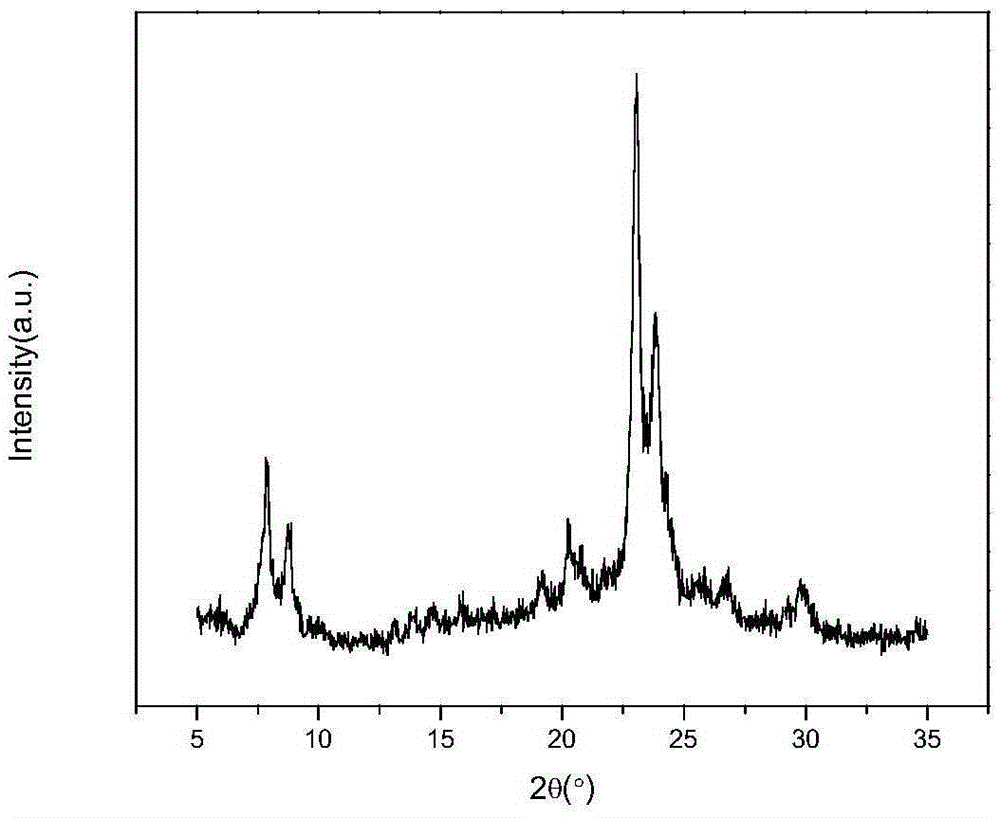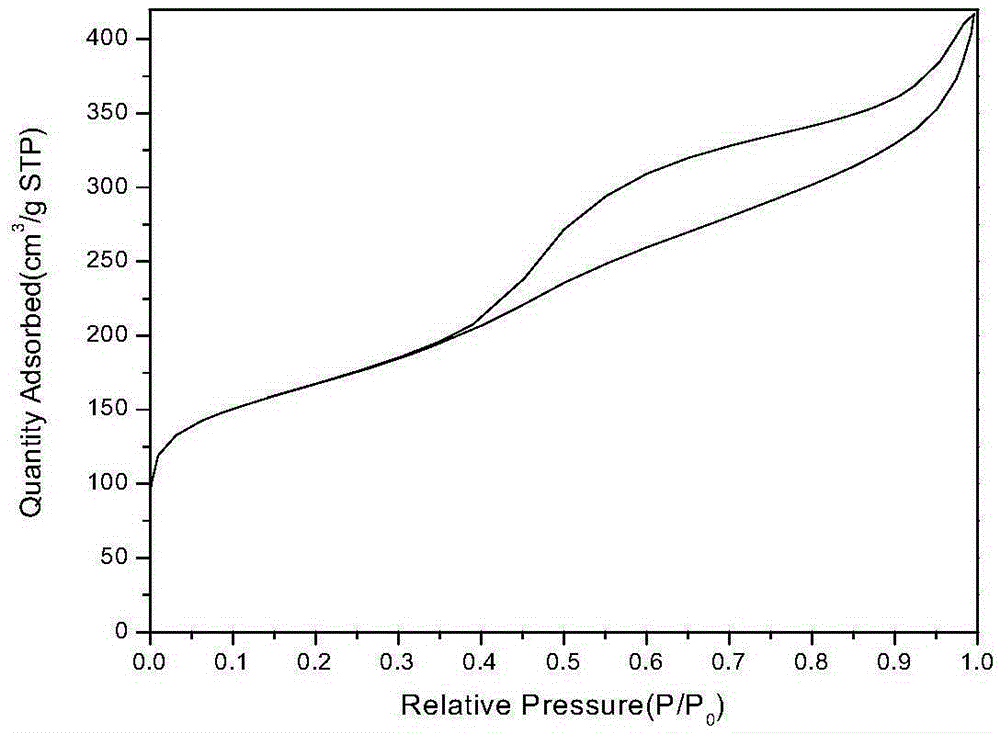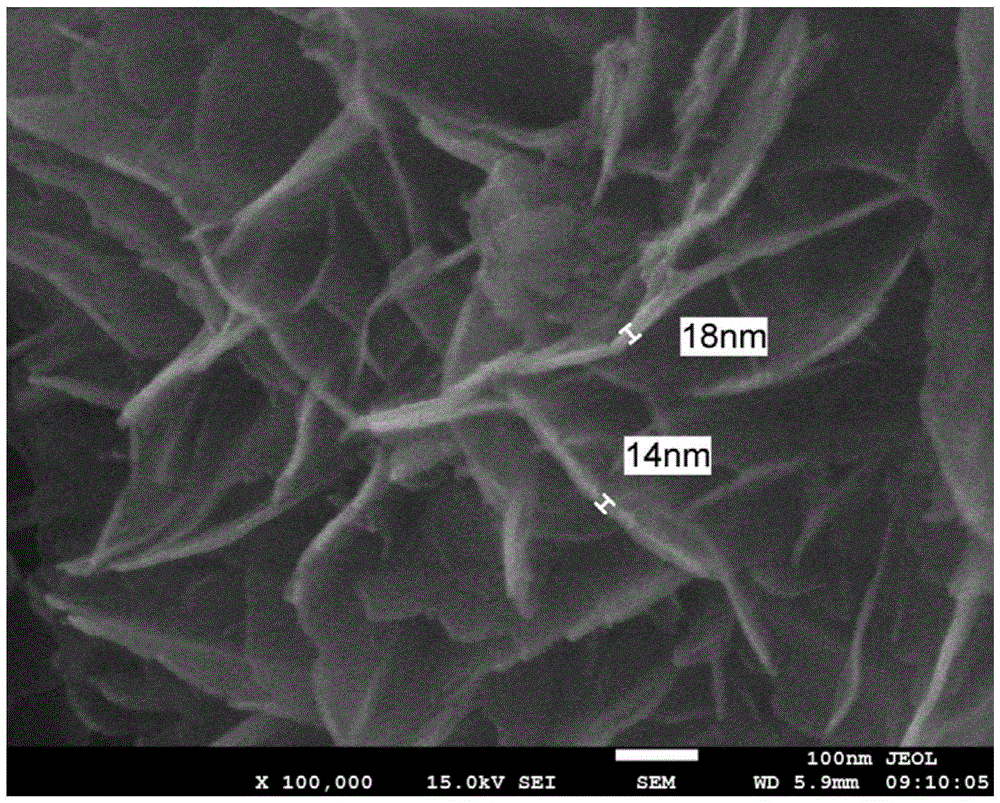A kind of preparation method and application of thin-layer nano-sheet all-silicon molecular sieve for preparing caprolactam
An all-silicon molecular sieve and nano-sheet technology, applied in the directions of silicon oxide and silicon dioxide, can solve the problems of complex process, low conversion rate, catalyst deactivation, etc., to reduce environmental pollution, improve catalytic activity, and reduce coking loss. live effect
- Summary
- Abstract
- Description
- Claims
- Application Information
AI Technical Summary
Problems solved by technology
Method used
Image
Examples
Embodiment 1
[0042] a. Add 51.6g of tetramethylhexamethylenediamine, 337ml of dimethyl carbonate, and 33.3g of bromooctadecane into a flat-bottomed flask, heat under reflux in a water bath at 50°C for 8 hours under stirring, cool to room temperature, and filter. Wash with dimethyl carbonate for 1-2 times, and air-dry to make the intermediate; add 50.5g of the intermediate, 300ml of ethanol, and 49.5g of bromohexane into a flat-bottomed flask, and heat under reflux in an oil bath at 79°C for 10 hours while stirring . After completion, heat up to 85°C, stir and dry to obtain a light yellow translucent solid, cool to room temperature, wash with ether 1-2 times, and obtain template C 18-6-6 Br 2 , the yield is 99%.
[0043] b. Add 4.98g of ethyl orthosilicate to 3.83g of tetramethylammonium hydroxide, stir at room temperature for 10 minutes, then add 17g of deionized water, 2.5g of ethanol, and 0.85g of the template agent C prepared in step a above 18-6-6 Br 2 , after stirring evenly, heat...
Embodiment 2
[0047] a. Add 86g of tetramethylhexamethylenediamine, 500ml of diethyl carbonate, and 39g of bromobehenic acid into a flat-bottomed flask, heat it under reflux in a water bath at 55°C for 5 hours under stirring, cool to room temperature, centrifuge, and Wash with diethyl carbonate for 1-2 times, and air-dry to make an intermediate; add 56.1g of the intermediate, 300ml of ethanol, and 33g of bromohexane into a flat-bottomed flask, and heat under reflux in an oil bath at 79°C for 10 hours while stirring. After completion, heat up to 85°C, stir and dry to obtain a yellow translucent solid, cool to room temperature, wash with ether 1-2 times, and obtain template C 22-6-6 Br 2 , the yield is 99.2%.
[0048] b. Add 4.98g of ethyl orthosilicate to 1.28g of tetramethylammonium hydroxide, stir at room temperature for 15 minutes, then add 14.40g of deionized water, 2.5g of ethanol, and 0.78g of the template prepared in step a above C 18-6-6 Br 2 After stirring evenly, heat in a wate...
Embodiment 3
[0051] a. Add 51.6g of tetramethylhexamethylenediamine, 350ml of dimethyl carbonate, and 24.9g of dodecane bromide into a flat-bottomed flask, heat under reflux in a water bath at 45°C for 10 hours under stirring, cool to room temperature, and centrifuge. Wash with dimethyl carbonate for 1-2 times, and air-dry to make the intermediate; add 42.1g of the intermediate, 300ml of propanol, and 20.55g of bromobutane into a flat-bottomed flask respectively, and heat under reflux in an oil bath at 85°C for 8 Hour. After completion, heat up to 90°C, stir and dry, cool to room temperature, and wash with ether 1-2 times to obtain template C 12-6-4 Br 2 , the yield is 99.3%.
[0052] b. Add 4.98g of tetraethylammonium hydroxide to 1.28g of tetraethylammonium hydroxide, stir at room temperature for 8 minutes, then add 18.90g of deionized water, 2.5g of ethanol, and 0.69g of the template prepared in step a above C 12-6-4 Br 2 After stirring evenly, heat in a water bath at 63°C for 1.5 ...
PUM
| Property | Measurement | Unit |
|---|---|---|
| specific surface area | aaaaa | aaaaa |
| specific surface area | aaaaa | aaaaa |
| specific surface area | aaaaa | aaaaa |
Abstract
Description
Claims
Application Information
 Login to View More
Login to View More - R&D
- Intellectual Property
- Life Sciences
- Materials
- Tech Scout
- Unparalleled Data Quality
- Higher Quality Content
- 60% Fewer Hallucinations
Browse by: Latest US Patents, China's latest patents, Technical Efficacy Thesaurus, Application Domain, Technology Topic, Popular Technical Reports.
© 2025 PatSnap. All rights reserved.Legal|Privacy policy|Modern Slavery Act Transparency Statement|Sitemap|About US| Contact US: help@patsnap.com



